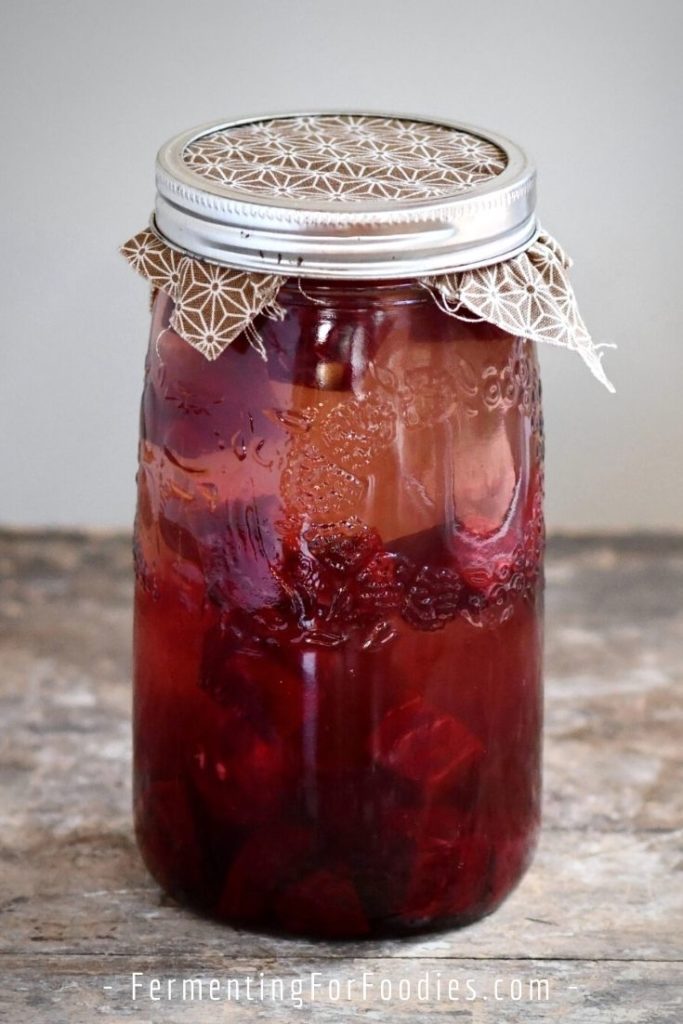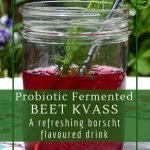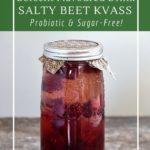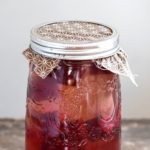Beet kvass is a refreshingly salty and sour fermented beverage. The flavor reminds me of clear Polish-style borscht and makes an excellent mid-afternoon drink.

It’s a perfect probiotic beverage for anyone looking to avoid sugar or dairy. While it’s not the same as a sparkling sweet kombucha, it’s just as packed with probiotics!
What is beet kvass?
Kvass is the Russian word for a fermented sparkling beverage. Beer likely originated from bread kvass. Brad’s Doukhobor cookbooks always have a recipe for cucumber kvass. Beet kvass is a simple beverage made from fermented beets. It can be salty or sweet, depending on whether you use salt or honey to control the fermentation.
I occasionally make sweet kvass, and I usually have a jar of immune-boosting kvass in my fridge all winter long. This salty beet kvass is another favorite.
Here are a few ways to enjoy this salty drink:
- Enjoy it as a tonic, taking a small shot of kvass every day.
- Serve with ice on a hot summer’s day.
- For a sparkling beverage, dilute it 50/50 with sparkling water.
- My Doukhobor cookbook suggests using it as a dip for fresh bread.
- Since organic beets are a fairly reliable ferment, this kvass can be used as a starter for other fermented vegetables.
- Personally, I like using kvass to make purple fermented eggs.
Simple Beet Kvass
Salty and sour beet kvass is a sugar-free fermented beverage that is refreshing on a hot day. It tastes similar to Polish borscht. It is a great source of probiotics and can be used to culture other vegetables.
- Prep Time: 10 minutes
- Total Time: 10 minutes
- Yield: 4 cups 1x
- Category: Beverages
- Method: Fermented
- Cuisine: Polish
- Diet: Low Calorie
Ingredients
- 1 medium-sized beet or 2 small beets (see notes)
- 2 tsp salt (non-iodized)
- 3 cups filtered water (chlorine-free)
Instructions
- Since this is a longer ferment, start with a clean and sanitized quart-sized jar.
- Wash the beet. Leave the skin on, but remove any bad spots. You don’t want to contaminate your ferment with mold
- Dice the beet into cubes and add to the jar. Use a weight to keep the beets from floating.
- Dissolve the salt in the water, and pour over the beets.
- Top with a lid that can handle fermentation. A fido jar or pickle pipe are both reliable options. But you can also just cover the jar with a loose-fitting lid or a cloth.
- Leave the beets to ferment in a dark location for at least 1 week, or up to 1 month.
- When you’re ready to drink the kvass, strain it into a bottle and store it in the fridge. Consume within 1 month of bottling.
Notes
- Organic, farm-fresh beets don’t require a starter, however, you can use sauerkraut juice or a purchased starter to get the ferment going.
- I don’t recommend making kvass with older beets (ones that have been stored for a few months) as they tend to go moldy. No one wants moldy kvass!
- You can flavor the kvass before drinking by adding dried dill and garlic powder (for a borscht flavor). Brad enjoys adding a stick of celery and drinking it like vegetable juice!
- The leftover beets are perfect for a Ukrainian salat.





I add a bit of ginger bug to mine to get things started.
What a good idea!
Can cooked beets be used for this recipe or do they have to be raw?
Unfortunately, this ferment requires the natural lactic bacteria on the skin of raw beets. So cooked beets won’t work for this recipe. However, I have used cooked beets to make Polish-style borscht. It’s fairly similar and delicious! I can’t recommend a specific recipe, as mine is in a cookbook. But I’m sure there’s a good one somewhere on the web. Cheers!
I used this to build up a cycling tonic for training session. Hit the spot, and hopefully made me faster!